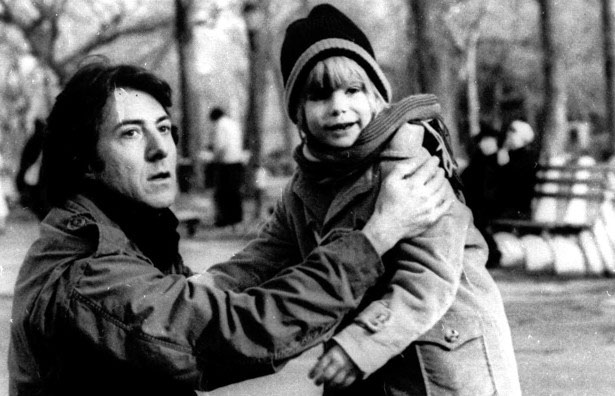Parenting
Orientation
Freshman (0 - 5)
Sophomore (6 - 10)
Junior (11 - 14)
Senior (15 - 18)
Stay at Home Dads
Single Dads
Divorced Dads
Legal Information
Dads Club
The Rise of the Single Dad
More than 2.6 million households in America are headed by a single father.

Dustin Hoffman plays a father fighting for custody of his son in the 1979 film Kramer vs. Kramer. AP File Photo
When his son, Kyle, was four months old, Stefan Malliet woke up to his crying at three o’clock in the morning. Stefan tried to figure out what was wrong—Kyle wasn’t hungry, his diaper wasn’t dirty, but he still wouldn’t settle down and go to sleep. He just kept screaming. With no one else in the house to take Kyle off his hands, Stefan called a friend, crying: “I had no idea what was going on.”
When I asked Stefan how he decided to take on the responsibilities of a single dad, he said, “This is my child. I have to be here.”
Today, more men than ever are making the same choice. A Pew Research study published this statistic this summer: 8 percent of households with minor children are now headed by a single father, up from just one percent in 1960. This represents a nine-fold increase, from fewer than 300,000 households in 1960 to more than 2.6 million in 2011. In contrast, the number of single-mother households increased four-fold during that time period, from 1.9 million in 1960 to 8.6 million in 2011.
These numbers speak to two trends in American family life today: a rising divorce rate over the past half-century, along with the increasing frequency of parents never marrying at all; and the growing societal acceptance of fathers as primary caregivers.
A century ago, this image of men left alone with children was enough to spur an anti-suffrage movement. So what happened? How did single fatherhood go from terrifying to increasingly normal?
According to the Pew study, we can attribute a large part of this to the U.S. judicial system, and it’s shifting standards for child custody cases. Until recently, U.S. courts would almost always rule “in the best interest of the child” (slang for “in favor of the mother”). But since the early 2000’s, many states have been adopting legislation that moves away from the “best interest” policy. Most new legislation provides for “joint parenting” or joint physical custody, policies that encourage both parents to spend equal time with the child (Oregon, Minnesota, Arizona, Iowa, and Maine have particularly strong joint parenting laws).
But rather than prompting divorced parents to split their child’s time 50-50, these policies seem to have prompted a dramatic increase in the number of single fathers.
More fathers are starting to believe that they have something important to contribute to their children’s lives.
A 2011 study published in the Journal of Empirical Legal Studies explains why this is happening. The study analyzes the case of Oregon, which in 1997 became one of the first states to formally enact joint parenting legislation. Before this change, Oregon’s custody law was pretty standard. It favored joint legal custody (the parents both have a say in decisions made about the child), but not joint physical custody. The decision about physical custody was made “in the best interest of the child,” which generally meant that the child lived with one parent or the other (and most often with the mother). After the new legislation, Oregon courts defaulted to joint parenting, encouraging the child to spend half her time with dad, and half her time with mom.
But this new law didn’t turn out the way legislators expected. Instead of increasing the number of families that split parenting time equally, it increased the numbers of fathers with sole custody.
There are a few reasons why the state push for joint parenting is resulting in more single dads.
It empowers fathers to ask for more, and believe they deserve it. William Fabricius, Professor of Psychology at Arizona State University and chair of Arizona’s on child custody statutes, says that most men want to share parenting time equally, but assume courts have a strong maternal bias.
“Dads think that the courts will favor mom, and so they will settle for less parenting time. They see other dads in the neighborhood who spend time with their kids every other weekend, and assume that’s the way it is.
They don’t ask for more parenting time because they don’t think it’s the norm,” Professor Fabricius said.
Since only five percent of child custody cases ever make it to trial, these perceptions of the norm are important. If men realize that courts are granting more parenting time to fathers than they have in the past, they’ll be more likely to ask for more time with their child, and fight to get it. Men used to assume that there was no way they’d get custody of their kids—and that maybe it was for the best.
“When most of my friends started having kids ten years ago, they all used to say, ‘I don’t know how to take care of a kid,’ and ‘that’s not what men are supposed to do,’” said Malliet.
But now attitudes are changing. More fathers are starting to believe that they have something important to contribute to their children’s lives. There might be a steep learning curve to single parenting, but men are much more likely to push through the three-in-the-morning screaming fits if other people – particularly the courts—think they can handle it.
Sharing is complicated. Joint physical custody can be a headache for two people who just don’t want much to do with each other anymore. It involves seeing your ex on a regular basis and living nearby so that your child can stay in one school.
“If you ask a woman what kind of custody deal she wants, she’d probably say that her first preference is for her to get sole custody, her second preference is for the father to get sole custody, and her third preference is joint custody,” said Margaret Brinig, the Fritz Duda Family Chair in Law at the University of Notre Dame and co-author of the Oregon study. “Most people don’t want to share.”
Malliet thinks the next big hurdle will be fathers having faith in themselves.
Page 1
Page 2
